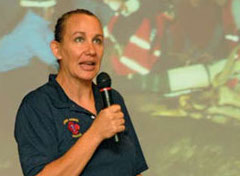Summit Minds Are Like Parachutes
 A note from BHPS Director Maddy Butcher:
A note from BHPS Director Maddy Butcher:
From a neurological point of view, sticking to your guns and doing what you’ve always done is the easiest thing to do. Our horse-keeping and riding habits – like reining patterns for the horse – are ingrained as super highways in our brains.
It’s much, much harder to admit that there’s more to learn, behaviorally speaking. It’s hard, too, to consider that someone else’s strategy might just be better and, therefore, worthy of incorporating into our routines.
In a recent article, 2018 Best Horse Practices presenter, Katrin Silva, used these lines from the late, great Chris LeDoux to illustrate this notion:
There’s always been groups of people
that never could see eye to eye.
and I always thought if they ever had a
chance to sit down and talk face to face.
They might realize they got a lot in common.
Last year, about 200 folks decided to give the Best Horse Practices Summit a try. Professionals, vets, trainers, and simple trail riders like me – they came from more than two dozen states with enthusiasm and open minds.

Warwick Schiller at the 2017 BHPS
As director of the Durango, Colorado conference, I could hardly get through those two and a half days without choking up with emotion, so incredibly heartening was it to see this diverse group “sit down and talk face to face,” as LeDoux would say.
The Summit is a cross-cultural affair with multi-dimensional intentions.
Like a lot of folks, I’m seeing more and more how lessons in horse work address universal strategies for life. How we choose to move forward with our horses also speaks to how we go through our days, deal with challenges, and approach problems and opportunities.
Recently, I asked horseman Mark Rashid about making these over-arching connections. He teaches Aikido, a martial art, to riders. But, he reflected, it could just as well be ballroom dancing or chess, because it’s all about mindfulness.
In horsemanship and in life, if we can learn to drop preconceived notions and shed our “Destination Addiction,” we improve our chances of getting the most out of our moments.
I’ve experienced this first hand: by slowing down with my troubled mule, Jolene, I’ve made faster progress. I took what I thought was a one-step procedure (haltering) and have broken it down to micro-moments to let her be better with it.
Warwick Schiller (a 2017 Summit presenter) has taken off this year to focus on this strategy of doing less to do more, he said. Schiller likes to encourage us all to channel our 10 year-old self, ie, to embrace moments of just hanging out with our horses instead of being so task-oriented.

Jim Thomas at the 2017 BHPS
Good things come from new approaches. It’s a belief widely shared by this year’s presenters and attendees alike. That’s why a brain scientist and a mustang trainer will share the stage. That’s why arena presentations will feature dressage and Western horsemanship simultaneously. Writes Katrin Silva, who with Amy Skinner, will present at the Summit in October (and who reminded me of the LeDoux lyrics):
“When we look more closely, we see that the differences between dressage and Western turn out to be superficial. There is much more common ground between them than most riders think, in terms of history, equipment, philosophy, and ultimately the goals of good horsemanship. We all want a relaxed, responsive horse that’s a joy to ride. Even if we don’t all follow the exact same path to get there, we want to end up in the same place.”
Emergency response is another area in which horse owners tend to think they know it all or can manage perfectly well without a professional’s input. After all, we horse owners are born MacGuyvers.

Dr. Rebecca Gimenez
Dr. Rebecca Gimenez has spent decades challenging this notion. I took her three-day course on Technical Large Animal Emergency Rescue. Twice. Trust me when I say that we, as a horse-owning population, need to learn more about swift water, barn fires, highway accidents, and sink hole crises.
Gimenez, who has presented at the American Association of Equine Practitioners and at important conferences around the world, will show us innovative strategies borne from first-hand experience and incident command work. It’s eye-opening stuff.
I hope you can make it to Durango in October. If you do, find me and tell me what you think of our gathering of speakers. Tell me if you enjoyed mixing with fellow attendees. Be part of an experience that’s all about reaching across divides, sitting down, and talking face to face. I think Chris LeDoux would have liked what he saw.

